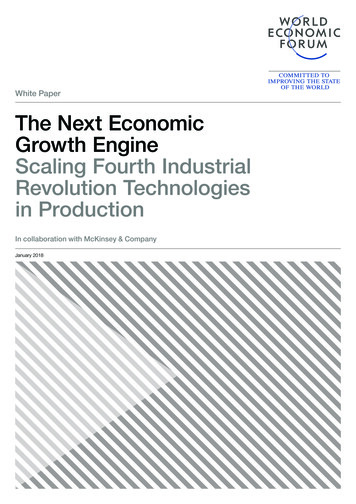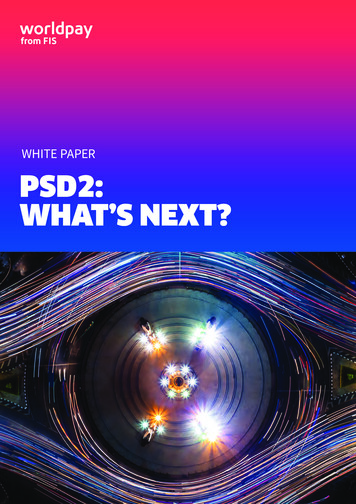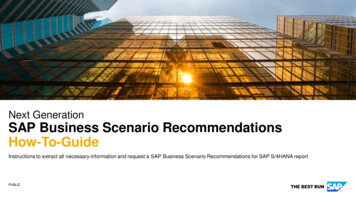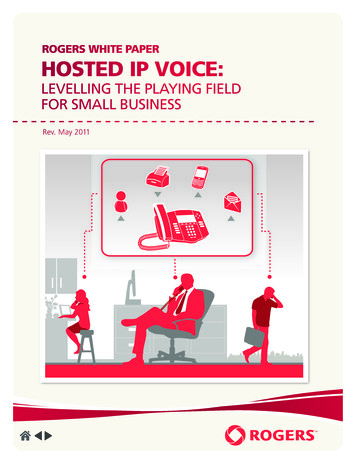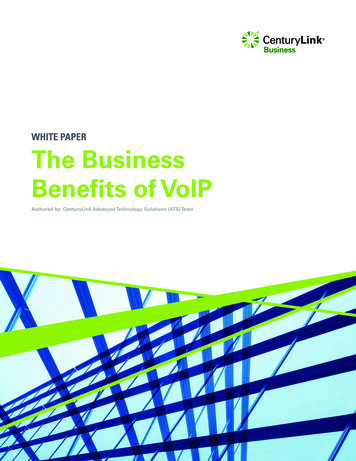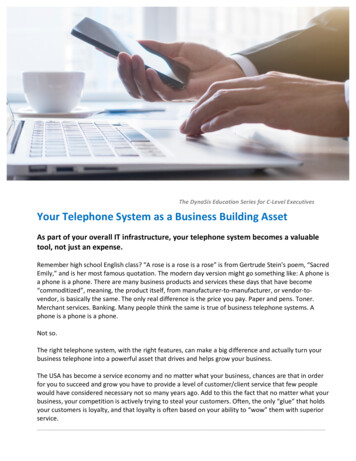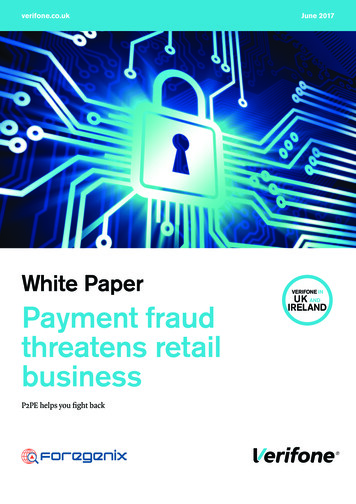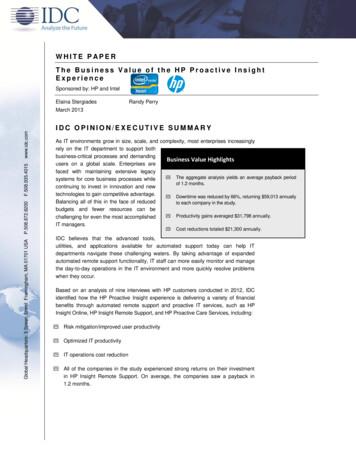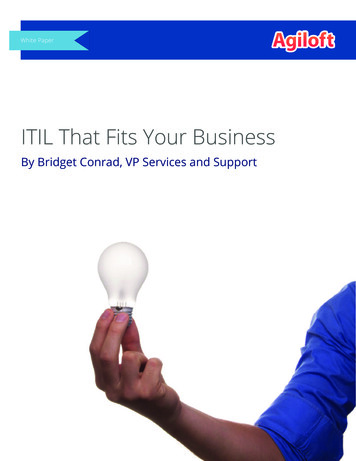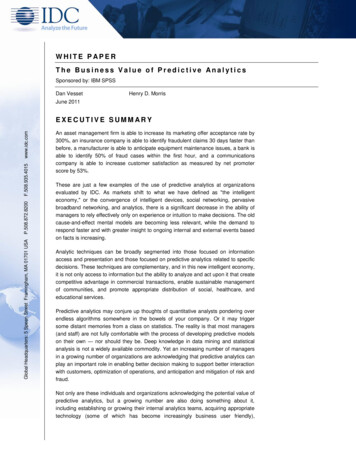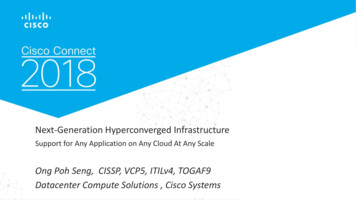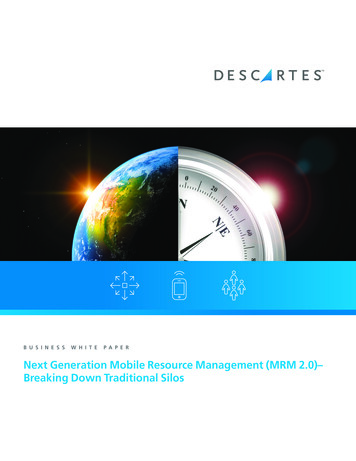
Transcription
B U S I N E S SW H I T EP A P E RNext Generation Mobile Resource Management (MRM 2.0)–Breaking Down Traditional Silos
B U S I N E S SW H I T EP A P E RNext Generation Mobile Resource ManagementUnifying Route Planning, Proof of Delivery (POD), and On-board Computers/DOTCompliance to Help Improve Performance and Return on InvestmentThe goal of Mobile Resource Management (MRM) is to help organizations enhance management of their commercial fleet assetsto be more effective in meeting customer service expectations, reducing risk, and complying with transportation regulations.Successful MRM deployments also help fleets reduce cost while improving productivity and performance.Historically, the MRM market has been fragmented and generally comprised of niche providers of route planning (both strategicand daily), route execution and POD, and on-board computers / Department of Transportation (DOT) Compliance solutions.While at the same time, many MRM consumers generally only focused on single pieces of the puzzle -stand alone planning,GPS-tracking, or DOT compliance solutions. This fragmentation has made it more difficult for customers to adopt a holistic MRMstrategy that collectively targets maximizing results, lowering cost of ownership, and reducing the risk of project failure.Next generation MRM providers have broken down these traditional silos. They leverage advances in mobile technology, whichmake the benefits of MRM more accessible than ever, and have positively altered the return on investment (ROI) paradigm thatfleet operators can achieve from today’s technology.The future of MRM is having a single vendor or systems integrator that can bring all the critical components together on a singleplatform, therefore helping avoid the traditional ‘silo’ pitfalls such as: No ability for planning systems to ‘learn’ from mobile data collection in the field; Brittle, multi-vendor integrations with high points of failure; High total cost of ownership associated with maintaining multiple systems; Manual processes to accurately factor in remaining DOT driver hours during the daily route planning process; Inability to effectively manage metrics-based driver incentive programs; and, Limited visibility to accurate, real-time pick-up/delivery information (POD, updated ETA, exceptions, etc.) for customerservice, sales, and end customersA holistic MRM strategy helps organizations avoid these pitfalls, while unlocking the potential savings and operationalimprovement potential of deploying next generation fleet technology which can include the following and much more: 10-15% in mileage savings from route planning; Eliminating 1 labor hour per driver per day with metrics-based driverperformance management; Eliminating 1.00 per stop by going paperless; Increasing fuel efficiency by 15% by improving driver behavior; and, Transforming the customer experience with access to real-time status information;The savings potential is significant. The average benefit for MRM 2.0 deployments can be as high as 1,000,000 for every 100vehicles in the fleet.MRM 2.0 Average Benefit Savings of 1,000,000 per 100 vehicleswww.descartes.com Page 2
B U S I N E S SW H I T EP A P E RNext Generation Mobile Resource ManagementCritical ComponentsSolutions for i) route planning, ii) route execution and mobile proof of delivery, and iii) on-board computers for vehicle trackingand DOT compliance, have traditionally been three separate silos that were generally sourced from separate technology vendors.By unifying these critical fleet management processes, operators can lower total cost of ownership while enabling their fleetand mobile resources to be more productive, offer new or improved services, better manage driver performance and cost ofcompliance with government regulations. Additionally, significant operational savings, in the range of 5-10%, can be achievedby leveraging holistic fleet management best practices and using a single integrated MRM platform.Route PlanningRoute planning and optimization solutions give logistics professionals the tools to maximize vehicle utilization and the efficiencyof their planners, dispatchers, drivers and other field personnel. Operating an efficient fleet and mobile workforce that meetscustomer service expectations begins with proper planning. There is a broad range of providers offering route optimizationsolutions that span a wide variety of scenarios from static territory and master route planning through to complex dynamicrouting models driven by real-time demand.These solutions take into consideration different business rules, customer requirements, asset parameters, driver capabilities,geographic data, and other constraints to create reliable routes using fewer trucks, miles and drivers. Traditional systems,offering standard capabilities, are generally batch-oriented point solutions that are better at handling more static scenarios anda more limited set of parameters. Advanced solutions leverage enterprise-class architecture and next generation continuousand incentive-centric optimization, handle large order sets and can accommodate complex parameters common to dynamicenvironments, such as same-day home delivery for retail, and demand driven vendor-managed replenishment in sectors such aspropane, less-than-truckload operations.Figure 1: Improving Route Efficiency - Before & After Optimizationwww.descartes.com Page 3
B U S I N E S SW H I T EP A P E RNext Generation Mobile Resource ManagementRoute Execution and Proof of Delivery (POD)Great route plans only go so far. Effective fleet operations require the flexibility to adjust and respond to the day-to-day realitiesonce vehicles leave the depot and execute on the road. It’s also an important best practice to continuously measure routeperformance against the route plan to achieve maximum productivity and to support continuous improvement.Operations benefit from mobile communication and GPS-based fleetwide visibility. These solutions can provide real-time statusupdates, which enable dynamically linked map, schedule and asset views, to provide information on key indicators such ascapacity usage, time to service each stop, customer time window violations, alternate available resources, route profitability,and more. Using this information, dispatchers are able to more effectively manage exceptions, assign new orders and coordinateactivities between drivers, call centers and other field resources, to streamline operations and enhance customer service.Figure 2: Managing Performance in Real-timeTurn-by-turn navigation systems offer multiple benefits to improve the execution of route plans while supporting safer driving.These solutions are most effective when they are integrated with a route planning and dispatch system and must considercommercial driving restrictions.Significant savings can be achieved by removing physical paper and manual processing costs through the use of mobile solutionswhich enable drivers to download routes to a wireless device, while transmitting status events and POD data, and whileexecuting in the field. Overages, damages, shorts, signatures, customer feedback, and more can be captured at each stop, whilethe information is automatically uploaded to back office systems in real-time. This improves visibility and data accuracy, supportsfaster billing cycles, mitigates fraudulent claims and helps to improve customer service overall.www.descartes.com Page 4
B U S I N E S SW H I T EP A P E RNext Generation Mobile Resource ManagementFigure 3a: Paperless Proof of Delivery ProcessPaper-Based to Paperless Document ManagementPaperwork transmittedwirelessly to the fieldStart-of-dayLoading ofOrders & PiecesDelivery &CollectionAccountingOrderProcessing& InvoicingAt key intervals,paperwork has beenvirtually eliminatedas data isconsolidated andcollected at eachstep and transmittedwirelesslyEnd-of-dayReconcilation &ReturnsProcessingCustomerReturnedItemsKey hubs highlighting the paper to paperlesstransformative process.Returns ProcessingPaperwork eliminated.Figure 3b: Paperless Proof of Delivery - Capturing Signatures, Pictures & Customer Feedbackwww.descartes.com Page 5DriverCommuncationExceptionHanding
B U S I N E S SW H I T EP A P E RNext Generation Mobile Resource ManagementOn-board Computers & DOT ComplianceIn addition to helping to comply with regulations related to Hours of Service (HOS) and fuel tax reporting, the latest generationof electronic on-board recording devices (EOBR) enables fleet operators to take advantage of capabilities beyond merecompliance. Fleets can maximize the benefits of telematics and advanced fleet tracking to improve driver behavior, enhanceproductivity and monitor vehicle diagnostic information in real-time.The elimination of manual data capture (paper logs), back office data re-entry, and processing time not only squeezes outunnecessary costs, but also removes transcription errors and the potential for falsification of data, helping to reduce regulatorycompliance risk. In contrast with manual, non-integrated methods, t he ability to automatically consider DOT compliance in thedaily route planning processes, not only improves accuracy, but can save planners hours of time.Improving driver behavior by effectively capturing real-time, quantitative data to support automation of driver scorecards forroute performance, idle time, speeding, and heavy braking can amount to huge savings. By eliminating one hour of idle timeper day and reducing the average fleet speed by 3mph, fleet operators have been able to save an average of 3,000 per vehicleper year. Significant additional savings can also be achieved in the vehicle maintenance area by reducing excessive tire, brakeand engine wear related to speeding, hard cornering, hard braking, engine over-revving, and so on – attributable to poor driverbehavior.Figure 4: Driver Performance ScorecardDriver ScorecardDriverAvg.StartTimeAM Time(Average)OnTime %% GPSMileage toStandard% Time toStandardScoreJohn Smith6:151478-2.60%-11%88%Brian James6:0071000.00%-20%100%Don Kenny7:12117623.00%13%54%Grant Sims5:4515.345-2.20%22%58%Mark Reynolds7:341089-0.60%-11%95%Mike Morris11:344.2321.10%8%77%Sean Jones6:0012.6902.20%1%90%Steve 83%www.descartes.com Page 6
B U S I N E S SW H I T EP A P E RNext Generation Mobile Resource ManagementTying the Pieces TogetherWhile most fleet operators desire a single integrated system for planning, execution, and telematics, they do not want to besystems integrators. It’s also unlikely that their own internal IT departments (if they have them) want or would be effective intaking on this role. It makes more financial and practical sense to procure these components from a single source. Aggressivemarket consolidation, across what used to be a ‘sea’ of small niche vendors, as well as, progress by leading vendors in broadeningtheir functional and technological capabilities, has lead to the MRM 2.0 convergence consumers require.Organizations that take advantage of end-to-end capabilities, through an integrated platform from a single, market-leadingvendor that can bring together optimized route planning, dispatch and GPS tracking, mobile applications, telematics, fleet/drivercompliance and performance analytics, can eliminate less effective ‘islands’ of automation, process differences, and unnecessarycosts that result from traditional silos.While the majority of fleet owners continue to struggle with isolated and outdated systems, best-in-class fleet operators,employing a unified approach, leverage bulk buying power, minimize implementation time and risk, derive greater ROI, andbenefit from dealing with one vendor that is accountable for success.Figure 5: End-to-end MRM 2.0 FunctionalityPlanvs.Strategic PlanningDaily PlanningTerritory DesignOrder ManagementFrequency & ServiceDay AssignmentAddress VerificationActualAVL, Mobile, Dispatch,EOBR/TelematicsPODScenario ModelingOptimizationCustomer ServiceMaster RoutesFine-tuningContinuous Closed Loop Reportingwww.descartes.com Page 7
B U S I N E S SW H I T EP A P E RNext Generation Mobile Resource ManagementThe Descartes DifferenceDescartes has been a leader and innovator in the fleet management space for more than 30 years. More than 32 million routesper year are managed using Descartes’ technology. Descartes’ Routing, Mobile and Telematics solutions are designed to helpfleet operators of all sizes increase the productivity of their fleets and mobile resources.Descartes is unique in the industry, in that, its Logistics Technology Platform leverages the three critical components of MRM on asingle unified platform: Route planning solutions that facilitate the proper design and daily execution of optimal route plans with basic throughadvanced capabilities, and flexible deployment options to address the needs of all types of organizations; Route execution solutions that leverage the latest innovations in mobile device technology, that monitor planned vs.actual performance, support dynamic order/work changes and assignments, and provide real-time information regardingstop/customer activities, and paperless proof of delivery; and On-board computer solutions, for telematics and DOT compliance that capture information about driver behavior, hoursof service, fuel tax reporting, plus diagnostics and other information about vehicle status/performance.Descartes has helped thousands of customers around the globe with enhanced command and control of their mobile workforceand fleet assets. The average estimated, quantifiable benefit from implementing the next generation mobile resourcemanagement is a savings of 1,000,000 per 100 vehicles. Qualitative benefits include more agile pick-up, delivery, and/or serviceoperations that are better able to respond to customer requirements and support growth.Finally, good fleet management practices are also good for our planet. Descartes has assisted the world’s leading fleets toproactively address environmental pressures to reduce fleet size, carbon emissions and eliminate paper.Figure 6: Holistic Approach to Save 1,000,000 per 100 VehiclesTraditional Silo ApproachThe Descartes DifferenceRouteExecution& PODRoutePlanningOn BoardComputers &DOT ComplianceHolisticApproachRoutePlanningOn BoardComputers &DOT ComplianceRouteExecution& PODPitfallsNo planned vs. actual 'learning'Risky and inflexible multi-vendor integrationsBenefits10-15% in mileage savings from route planning thatcontinuously 'learns'High total cost of ownershipReduce labor costs with metrics-based driver performancemanagementManual planning processes to consider DOT complianceEliminate 1.00 per stop by going paperlessLess effective driver improvement programs15% increase in fuel efficiency by improving driver behaviorLimited interdepartmental and customer visibilityImprove customer satisfaction with access to real-time ETAswww.descartes.com Page 8
B U S I N E S SW H I T EP A P E RNext Generation Mobile Resource ManagementTo learn more on how unifying critical fleet management processes can unleash the potential of your fleet operations pleasecontact info@descartes.com.About DescartesDescartes (TSX:DSG) (Nasdaq:DSGX) is the global leader in providing on-demand, software-as-a-service solutions focused onimproving the productivity, performance and security of logistics-intensive businesses. Descartes has over 172,000 connectedparties using its cloud based services. Customers use our modular, software-as-a-service solutions to route, schedule, track andmeasure delivery resources; plan, allocate and execute shipments; rate, audit and pay transportation invoices; file customs andsecurity documents for imports and exports; and complete numerous other logistics processes by participating in the world’slargest, collaborative multi-modal logistics community. Our headquarters are in Waterloo, Ontario, Canada and we have officesand partners around the world. Learn more at www.descartes.com.The Descartes Systems Group Inc. TSX: DSG NASDAQ: DSGX 120 Randall Drive, Waterloo, Ontario, N2V 1C6, CanadaToll Free 800.419.8495 Int‘l 519.746.8110 info@descartes.com www.descartes.com Copyright 2014 The Descartes Systems Group Inc. All rights reserved. Descartes, the Descartes triad logo and all product names used are Descartes trademarks unless specifically identified as the trademarks of a third party.
activities between drivers, call centers and other fi eld resources, to streamline operations and enhance customer service. Figure 2: Managing Performance in Real-time Turn-by-turn navigation systems offer multiple benefi ts to improve the
